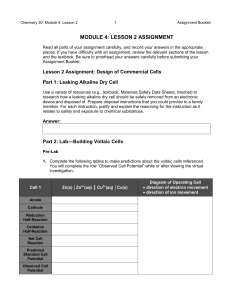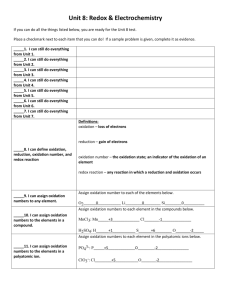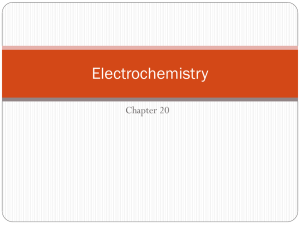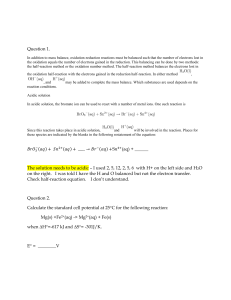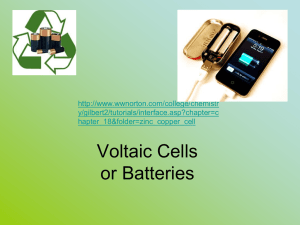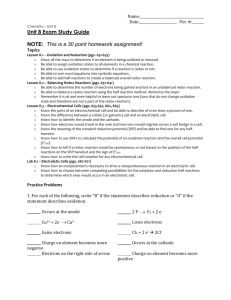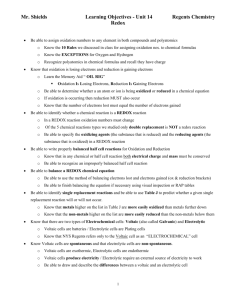CellPotential_Printable
advertisement
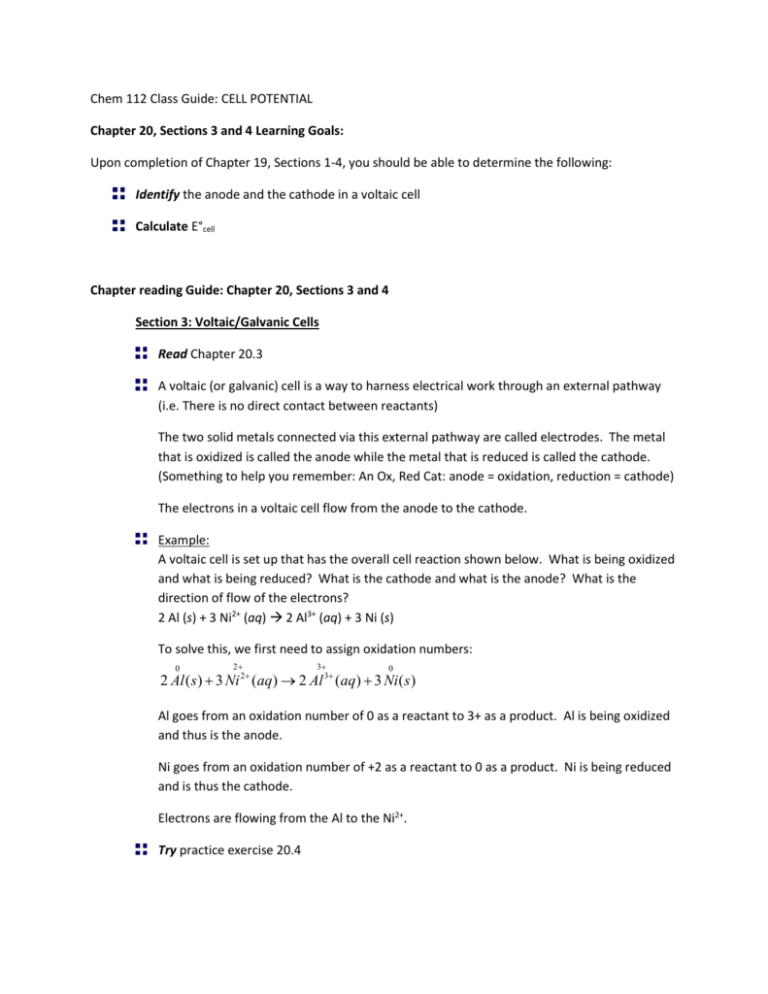
Chem 112 Class Guide: CELL POTENTIAL Chapter 20, Sections 3 and 4 Learning Goals: Upon completion of Chapter 19, Sections 1-4, you should be able to determine the following: Identify the anode and the cathode in a voltaic cell Calculate E°cell Chapter reading Guide: Chapter 20, Sections 3 and 4 Section 3: Voltaic/Galvanic Cells Read Chapter 20.3 A voltaic (or galvanic) cell is a way to harness electrical work through an external pathway (i.e. There is no direct contact between reactants) The two solid metals connected via this external pathway are called electrodes. The metal that is oxidized is called the anode while the metal that is reduced is called the cathode. (Something to help you remember: An Ox, Red Cat: anode = oxidation, reduction = cathode) The electrons in a voltaic cell flow from the anode to the cathode. Example: A voltaic cell is set up that has the overall cell reaction shown below. What is being oxidized and what is being reduced? What is the cathode and what is the anode? What is the direction of flow of the electrons? 2 Al (s) + 3 Ni2+ (aq) 2 Al3+ (aq) + 3 Ni (s) To solve this, we first need to assign oxidation numbers: 0 2 3 0 2 Al ( s ) 3 Ni 2 (aq) 2 Al 3 (aq) 3 Ni ( s ) Al goes from an oxidation number of 0 as a reactant to 3+ as a product. Al is being oxidized and thus is the anode. Ni goes from an oxidation number of +2 as a reactant to 0 as a product. Ni is being reduced and is thus the cathode. Electrons are flowing from the Al to the Ni2+. Try practice exercise 20.4 Section 4: CELL POTENTIAL UNDER STANDARD CONDITIONS Read Chapter 20.4 The difference in potential energy per charge between two electrodes is called the potential difference and is measured in volts (V). The potential difference between two electrodes connected via an external pathway is called the cell potential or electromotive force (emf). THE CELL POTENTIAL OF ANY VOLTAIC CELL IS POSITIVE! (Forget what you may have been taught in high school – this will be explained more in section 5.) In order to calculate the cell potential of any voltaic cell, simply use the following equation: o o o Ecell Ecathode Eanode Most of the time, the potentials of half-reactions are given as reductions (see Appendix E). It is your responsibility to determine which half-reaction is the reduction half-reaction and which half-reaction is the oxidation half-reaction. Put simply, the half-reaction that is more negative will be the oxidation half reaction. The half-reaction that is more positive will be the reduction half-reaction. Example: You wish to make a voltaic cell using hydrogen gas and fluorine gas. What is the overall cell reaction? Also, calculate Ecell using the values found in Appendix E. When we look at Appendix E, we see the following two reactions: 2 H+ (aq) + 2 e- H2 (g) F2 (g) + 2 e- 2 F- (aq) Ered = 0 Ered = +2.87 The half reaction that is more negative is the oxidation half reaction. So the H+ reaction will be the oxidation half reaction (0 is more negative than +2.87). Now that we’ve decided that, we can re-write this reaction as an oxidation: H2 (g) 2 H+ (aq) + 2 eAnd add it to the reduction half reaction to get the overall cell reaction (remember to multiply the half reactions to get the same number of electrons if necessary): H 2 ( g ) 2 H (aq) 2e F2 ( g ) 2e 2 F (aq) F2 ( g ) H 2 ( g ) 2 H (aq) 2 F (aq) Now, we can calculate Ecell Ecell Ecathode Eanode Remember that oxidation occurs at the anode (AN OX) so hydrogen is the anode. Reduction occurs at the cathode (RED OX) so fluorine is the cathode. Ecell Ecathode Eanode 2.87 0 2.87 Try Practice Exercise 20.5, 20.6 and 20.7. Learning Resources Chapter Learning Goals Chapter 20, Sections 3 and 4 Learning Goals Pre Class Assignment: This assignment must be completed prior to the next class. Check your syllabus for the exact due date and time. Complete to the pre class assignment (http://berks.psu.edu/clt/chem112/CellPotentialReactions_HW.docx) Submit a copy to the dropbox located in ANGEL called “Pre Class Assignment Submission: Cell Potential” End of Chapter Problems: Practice with these problems if you are having difficulty with any of the concepts covered in this class guide AFTER we have met in class. If you cannot easily complete these problems, seek help from your instructor, your mentor or the learning center Chapter 20: 27, 37, 39



